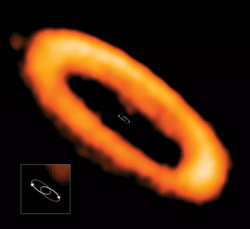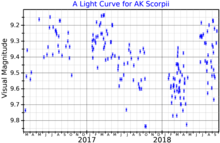 The star system AK Scorpii imaged by ALMA. The Binary star orbit was added for clarity. Credit: ALMA (ESO/NAOJ/NRAO), I. Czekala and G. Kennedy; NRAO/AUI/NSF, S. Dagnello | |
| Observation data Epoch J2000.0 Equinox J2000.0 | |
|---|---|
| Constellation | Scorpius |
| Right ascension | 16 54 44.8498 |
| Declination | −36° 53′ 18.561″ |
| Apparent magnitude (V) | 9.00 |
| Characteristics | |
| Spectral type | F 5 IV-V |
| Apparent magnitude (G) | 9.2823 ± 0.0223 |
| Variable type | Herbig Ae/Be star |
| Astrometry | |
| Radial velocity (Rv) | -1.97 ± 0.5 km/s |
| Proper motion (μ) | RA: −8.399±0.116 mas/yr Dec.: −29.268±0.083 mas/yr |
| Parallax (π) | 7.1126 ± 0.0621 mas |
| Distance | 459 ± 4 ly (141 ± 1 pc) |
| Orbit | |
| Primary | AK Scorpii A |
| Companion | AK Scorpii B |
| Period (P) | 13.609 ± 0.001 days |
| Semi-major axis (a) | 0.16 au |
| Eccentricity (e) | 0.47 ± 0.01 |
| Inclination (i) | 115 ± 3° |
| Longitude of the node (Ω) | 48 ± 3° |
| Argument of periastron (ω) (secondary) | 186 ± 2° |
| Semi-amplitude (K1) (primary) | 64.7 ± 0.9 km/s |
| Semi-amplitude (K2) (secondary) | 65.5 ± 0.9 km/s |
| Details | |
| AK Scorpii A | |
| Mass | 1.25 M☉ |
| Age | 18 Myr |
| AK Scorpii B | |
| Mass | 1.25 M☉ |
| Age | 18 Myr |
| Other designations | |
| HD 152404, CD-36 11056, HIP 82747, IRAS 16514-3648, 2MASS J16544485-3653185 | |
| Database references | |
| SIMBAD | AB |
AK Scorpii is a Herbig Ae/Be star and spectroscopic binary star about 459 light-years distant in the constellation Scorpius. The star belongs to the nearby Upper Centaurus–Lupus star-forming region and the star is actively accreting material. The binary is surrounded by a circumbinary disk that was imaged with VLT/SPHERE in scattered light and with ALMA.
Characteristics

AK Scorpii is about 18 million years old, which is young on astronomical timescales. The binary consists out of two stars with an equal mass of 1.25 M☉ respectively and the two stars orbit each other within 13.6 days. The binary is surrounded by a narrow ring of dust with a radius of about 30 astronomical units and the gap between the binary and the dust disk is filled by some gas.
The binary is in an eccentric orbit that causes variable accretion rates due to gravitational interactions with the disk. During the furthest point in the orbit of the binary (apastron), matter is dragged from the inner disk border into the gap. The material forms accretion streams that fill ring-like structures around each component of the binary. At the closest point in the orbit (periastron), the ring-like structures come into contact, leading to an angular momentum loss and thus producing an accretion outburst.
In August 2014 the system was observed with the Hubble Space Telescope during the periastron passage. The telescope observed a drop of the hydrogen flux, which is explained by the occultation of the star by a gas stream falling towards the star. The system also shows an enhanced X-ray and ultraviolet flux with XMM-Newton data during periastron, which is an additional sign of stronger accretion during periastron.
The orbital inclination of the binary and the inclination of the circumbinary disk is nearly the same. Any circumbinary planet that could form in this disk would orbit in the same plane as the binary.
The spectrum of the stars shows that their atmosphere is overabundant in the chemical elements yttrium, barium, and lanthanum. The primary additionally shows an overabundance of zirconium and the secondary is overabundant in sulphur.
References
- ^ Brown, A. G. A.; et al. (Gaia collaboration) (August 2018). "Gaia Data Release 2: Summary of the contents and survey properties". Astronomy & Astrophysics. 616. A1. arXiv:1804.09365. Bibcode:2018A&A...616A...1G. doi:10.1051/0004-6361/201833051. Gaia DR2 record for this source at VizieR.
- ^ Castelli, F.; Hubrig, S.; Järvinen, S. P.; Schöller, M. (January 2020). "The chemical composition of the Herbig Ae SB2 system AK Sco (HD 152404)". MNRAS. 491 (2): 2010–2024. arXiv:1910.09372. Bibcode:2020MNRAS.491.2010C. doi:10.1093/mnras/stz3015. ISSN 0035-8711. S2CID 204801058.
- ^ Anthonioz, F.; Ménard, F.; Pinte, C.; Le Bouquin, J.-B.; Benisty, M.; Thi, W.-F.; Absil, O.; Duchêne, G.; Augereau, J.-C.; Berger, J.-P.; Casassus, S. (January 2015). "The VLTI/PIONIER near-infrared interferometric survey of southern T Tauri stars. I. First results". Astronomy & Astrophysics. 574: A41. arXiv:1412.1052. Bibcode:2015A&A...574A..41A. doi:10.1051/0004-6361/201424520. ISSN 0004-6361.
- ^ Czekala, Ian; Chiang, Eugene; Andrews, Sean M.; Jensen, Eric L. N.; Torres, Guillermo; Wilner, David J.; Stassun, Keivan G.; Macintosh, Bruce (September 2019). "The Degree of Alignment between Circumbinary Disks and Their Binary Hosts". Astrophysical Journal. 883 (1): 22. arXiv:1906.03269. Bibcode:2019ApJ...883...22C. doi:10.3847/1538-4357/ab287b. hdl:10023/29186. ISSN 0004-637X. S2CID 182952526.
- ^ Czekala, I.; Andrews, S. M.; Jensen, E. L. N.; Stassun, K. G.; Torres, G.; Wilner, D. J. (June 2015). "A Disk-based Dynamical Mass Estimate for the Young Binary AK Sco". Astrophysical Journal. 806 (2): 154. arXiv:1505.01850. Bibcode:2015ApJ...806..154C. doi:10.1088/0004-637X/806/2/154. ISSN 0004-637X. S2CID 14513671.
- Janson, Markus; Thalmann, Christian; Boccaletti, Anthony; Maire, Anne-Lise; Zurlo, Alice; Marzari, Francesco; Meyer, Michael R.; Carson, Joseph C.; Augereau, Jean-Charles; Garufi, Antonio; Henning, Thomas (January 2016). "Detection of Sharp Symmetric Features in the Circumbinary Disk around AK Sco". Astrophysical Journal Letters. 816 (1): L1. arXiv:1512.04552. Bibcode:2016ApJ...816L...1J. doi:10.3847/2041-8205/816/1/L1. hdl:2268/243722. ISSN 0004-637X. S2CID 53609671.
- "ASAS-SN Variable Stars Database". ASAS-SN Variable Stars Database. ASAS-SN. Retrieved 6 January 2022.
- ^ Gómez de Castro, Ana I.; López-Santiago, Javier; Talavera, Antonio; Sytov, A. Yu; Bisikalo, D. (March 2013). "XMM-Newton Monitoring of the Close Pre-main-sequence Binary AK Sco. Evidence of Tide-driven Filling of the Inner Gap in the Circumbinary Disk". Astrophysical Journal. 766 (1): 62. arXiv:1301.6966. Bibcode:2013ApJ...766...62G. doi:10.1088/0004-637X/766/1/62. ISSN 0004-637X.
- Gómez de Castro, Ana I.; Loyd, Robert O. P.; France, Kevin; Sytov, Alexey; Bisikalo, Dmitry (February 2016). "Protoplanetary Disk Shadowing by Gas Infalling onto the Young Star AK Sco". Astrophysical Journal Letters. 818 (1): L17. arXiv:1602.02585. Bibcode:2016ApJ...818L..17G. doi:10.3847/2041-8205/818/1/L17. ISSN 0004-637X. S2CID 54604633.
- "The Strange Orbits of 'Tatooine' Planetary Disks". ALMA. 2020-03-19. Retrieved 2020-03-21.
This binary or multiple star system–related article is a stub. You can help Misplaced Pages by expanding it. |
This article about a red dwarf is a stub. You can help Misplaced Pages by expanding it. |